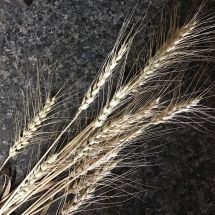
When teaching about whole grains, I like to cover the following six categories: wheat, oats, rye, rice, corn and barley. I do this as an overview because it’s a great way to introduce and expose students to a variety of whole grains that can be incorporated into different meals. After all, 100% whole grains are part of a healthy, nutritious diet!
Set
- Bell Ringer: Ask students individually unscramble the whole grains in the handout (these are the categories of grains we will be learning about). Place a star beside those you’ve eaten.
- Go over the correct answers and tally grains consumed. Our Ag department has samples of the grains that I borrow and show to students so they can see the real thing. This is optional but may be worth checking with your Ag department just in case!
Materials
- iPads or Laptops
- Device or Camera for Photographs
- Play-doh in Various Colors
- Actual Grain Samples (optional)
Activities
- Place students into small groups to work through the following stations in any order.
- Station #1: Create a Mnemonic
- Write an original, creative mnemonic (acronym or acrostic) for the six types of whole grains, using the first letter of each grain on the backside of your unscrambled grains handout. This is to help students remember the categories.
- Station #2: Parts of a Grain Kernel
- Using three different colors of play-doh and a reliable source, recreate the grain kernel. Be sure to label the parts, provide a brief description and include the nutrition component(s) of each part when in its whole state. Be sure to cite your source. Take a photo of your diagram and attach it to Google Classroom along with your source
- Station #3: What’s the Difference between Whole Grains & Refined Grains?
- Create a T-Chart with the following headings: Whole Grains & Refined Grains. View the YouTube video titled “Whole grains vs. Refined grains explained with examples” and fill in the t-chart with the information that highlights the differences between the two.
- As a whole class, process and go over the information the students learned about. Ask students to share their mnemonic creations, go over the parts of the grain kernel and distinguish the characteristics that separate whole and refined grains.
- To help students understand the history, geography and nutrition of each of the six grains, I like to place them into groups of six if possible. I provide all of groups with an information sheet for each grain. Each student takes one and reads through it learning more about one specific grain. When everyone it done reading, students get a copy of the final challenge titled, “Name that Grain!. I have each student fill out a worksheet so they have a copy for their notes, but they work together as a group so they can use the information sheets that each person has read and learned more about.
- Optional activity: You could also assign students grain related vocabulary terms to learn and practice while they wait for other groups to finish.
- Once all groups have finished their Name that Grain! challenge, you can either go over and correct as a class or collect and grade. If I was grading this, I would pass it back the following day and have them work in their groups to correct any incorrect answers. It forces them to work with the information, making them more accountable and helps to improve their grade. This time when I grade it, whatever the new grade is will be averaged with the first grade to equal the final grade.
Attachments
- Unscramble the Grains (PDF)
- Wheat Information Sheet (PDF)
- Oats Information Sheet (PDF)
- Rye Information Sheet (PDF)
- Rice Information Sheet (PDF)
- Corn Information Sheet (PDF)
- Barley Information Sheet (PDF)
- Name that Grain! Challenge (PDF)
- Name that Grain! Challenge–Key (PDF)

